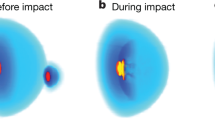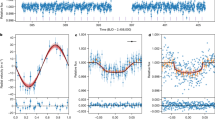Abstract
The interior structure of Jupiter serves as a benchmark for an entire astrophysical class of liquid–metallic hydrogen-rich objects with masses ranging from ~0.1M J to ~80M J (1M J = Jupiter mass = 1.9e30 g), comprising hydrogen-rich giant planets (mass < 13M J) and brown dwarfs (mass > 13M J but ~ < 80M J), the so-called substellar objects (SSOs). Formation of giant planets may involve nucleated collapse of nebular gas onto a solid, dense core of mass ~0.04M J rather than a stellar-like gravitational instability. Thus, detection of a primordial core in Jupiter is a prime objective for understanding the mode of origin of extrasolar giant planets and other SSOs. A basic method for core detection makes use of direct modeling of Jupiter’s external gravitational potential terms in response to rotational and tidal perturbations, and is highly sensitive to the thermodynamics of hydrogen at multi-megabar pressures. The present-day core masses of Jupiter and Saturn may be larger than their primordial core masses due to sedimentation of elements heavier than hydrogen. We show that there is a significant contribution of such sedimented mass to Saturn’s core mass. The sedimentation contribution to Jupiter’s core mass will be smaller and could be zero.
Similar content being viewed by others
References
Fortney, J.J. and Hubbard, W.B.: 2003, Icarus 164, 228.
Fortney, J.J. and Hubbard, W.B.: 2004, ApJ 608, 1039.
Gautier, D., Hersant, F., Mousis, O. and Lunine, J.I.: 2001, ApJ 550, L227; Erratum 559, L183.
Guillot, T., Gautier, D. and Hubbard, W.B.: 1997, Icarus 130, 534.
Hubbard, W.B.: 1977, Icarus 30, 305.
Hubbard, W.B. and Stevenson, D.J.: 1984, in: T. Gehrels and M. Matthews (eds.), Saturn, University of Arizona Press, Arizona, p. 47.
Hubbard, W.B. and DeWitt, H.E.: 1985, ApJ 290, 388.
Hubbard, W.B., Burrows, A. and Lunine, J.I.: 2002, Annu. Rev. Astronom. Astrophys. 40, 103
Mizuno, H.: 1980, Prog. Theor. Phys. 64, 544.
Pfaffenzeller, O., Hohl, D. and Ballone, P.: 1995, Phys. Rev. Lett. 74, 2599.
Ross, M.: 1998, Phys. Rev. B 58, 669.
Saumon, D., Chabrier, G. and van Horn, H.M.: 1995, ApJS 99, 713.
Stevenson, D.J. and Salpeter, E.E.: 1977a, ApJS 35, 221.
Stevenson, D.J. and Salpeter, E.E.: 1977b, ApJS 35, 239.
Stevenson, D.J.: 1975, Phys. Rev. B 12, 3999.
Von Zahn, U. and Hunten, D.M.: 1996, Science 272, 849.
Author information
Authors and Affiliations
Corresponding author
Rights and permissions
About this article
Cite this article
Hubbard, W.B. Hydrogen Eos at Megabar Pressures and the Search for Jupiter’s Core. Astrophys Space Sci 298, 129–134 (2005). https://doi.org/10.1007/s10509-005-3922-4
Received:
Accepted:
Issue Date:
DOI: https://doi.org/10.1007/s10509-005-3922-4




